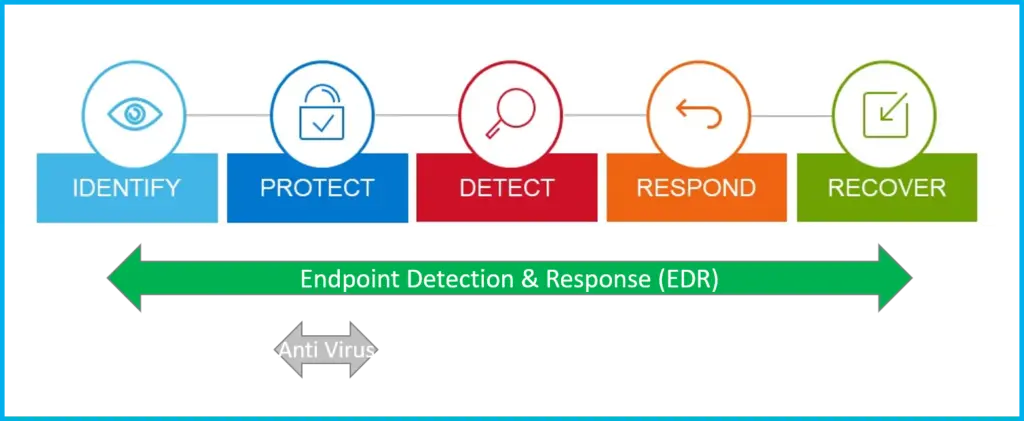As technology has become increasingly sophisticated, so have the tactics used by cybercriminals. Malware is one of the most severe threats to business and personal security, as it can be used to steal data, disable systems, and cause other malicious activities. Fortunately, powerful tools are available to help detect and prevent malware, such as Endpoint Detection and Response (EDR). In this blog, we will explore the power of EDR and how it can help uncover malicious activity and protect your endpoint devices from cyber threats.

Brief working of EDR
Endpoint Detection and Response, also referred to as endpoint detection and threat response (EDTR), is an important endpoint security solution that continuously monitors and analyzes system activities to detect, contain, investigate, and respond to advanced threats. It helps organizations identify potentially malicious activities on their endpoints in real time and quickly respond accordingly.
EDR security solutions give companies an all-encompassing view of their activities and events so that incidents can be identified faster and more efficiently. An EDR solution should offer continuous and thorough monitoring of endpoints in real-time.
An EDR tool should offer comprehensive protection against threats, providing data search and investigation, alert triage, validation of suspicious activity, threat hunting and detection/containment of malicious activity.
Importance Of EDR
EDR should be essential to any organization's endpoint security strategy because adversaries will eventually find a way in, given enough time and resources.
Endpoint security solutions can fail, leaving organizations vulnerable to attackers who can exploit these weaknesses and linger in the network.
Silent failure can allow attackers to access an organization's environment, often without detection. The breach is often only discovered once an external source alerts the organization.When a breach is discovered, organizations lack the visibility to understand what happened and how to fix it, making remediation take months - only for attackers to return quickly.Organizations need more visibility into their endpoints and help storing and promptly accessing security-relevant data.
Organizations without advanced capabilities risk financial loss due to re-imaging machines, which disrupts productivity and business processes.
How Can EDR Detect Malware?
EDR helps protect networks by detecting malicious activities like malware, suspicious file downloads, and unusual network traffic.
EDR systems detect suspicious activity and alert organizations, giving detailed information about the source, type of malware and potential damage. This data helps monitor networks and analyze behaviour.
EDR solutions provide organizations with critical network security and protection from malicious activity, such as malicious website blocking, file detection, and threat identification.
How to Choose an EDR Solution?
Choosing an EDR solution can be daunting, as many options are available. When selecting an EDR solution, organizations should consider the following factors:
- It is important to choose an EDR solution that is reliable and secure. Look for solutions that offer advanced security features, such as encryption and two-factor authentication.
- The EDR solution should be scalable to accommodate the organization's changing needs.
- Cost is an important factor when selecting an EDR solution. It is important to choose a cost-effective solution that fits within the organization's budget.
- The EDR solution should have reliable customer support to help organizations with issues or questions.
- Cloud-based endpoint detection and response is the best way to protect endpoints while allowing real-time search, analysis and investigation capabilities.
Uses Of EDR
- Endpoint visibility allows organizations to monitor and stop malicious attacks in real time.
- It requires a large amount of telemetry to detect signs of attack, which can be mined using analytics.
- An endpoint detection and response solution with integrated threat intelligence provides valuable insight and context, such as details of an attack and the attributed adversary.
- EDR can quickly and effectively prevent attacks from becoming breaches, allowing organizations to get back to business faster.
Conclusion
Endpoint detection and response is a form of security technology that allows organizations to detect, respond to, and report on malware, including any malicious activity that has taken place on their network. It is unique in its ability to detect and correlate a wide range of malicious activities automatically. With deep visibility into the behaviour of each endpoint on the network, EDR can detect malware, even the most subtle malicious activity that traditional prevention methods may miss. Once the malicious behaviour has been detected, EDR can provide administrators with reports and insights into what transpired, enabling a rapid response to the threat.
FAQ section
A: Yes, EDR is an endpoint security solution that offers real-time continuous monitoring and detection mechanism for endpoint devices to detect and respond to malware, ransomware, and other cyber threats.
A: Most of the ransomware uses advanced and emerging threats which is unable to be detected by normal antivirus. EDR on the other hand can detect and contain advanced ransomware within seconds.
A: Antivirus can detect, contain and remove malware on a device using various signature detection mechanisms. while EDR includes Antivirus along with other features that are regarded as a complete package for protection from a broad range of threats.
A: Malware detection is carried out by signature-based detection which is known as a digital indicator of malware. Once a suspicious behavior is identified through Indicators of Compromise, software that maintains the database reacts to contain the malware.
